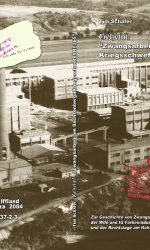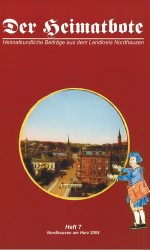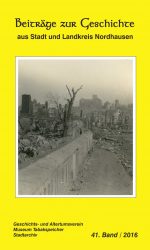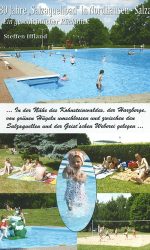Description
The Nordhausen history- and Antiquity Society and the City Archives are again publishing a volume in the book series "Contributions to the History of the City and District of Nordhausen" this year. From now on it is 47. Volume in the regional bookstores and at the publisher Steffen Iffland for 20 Euro erhältlich. To good 200 Pages comes from the volume with eleven topics 14. century up to this 21. Century.
Paul Lauerwald's essay on the coinage of the Reich Mint in Nordhausen marks the beginning. Der Beitrag „The fire rages in the city. …” is about the works of the high school principal Johann Joachim Meier in Nordhausen. The authors Karl W. Beichert and Wilhelm Kühlmann deal with e.g. a. with the texts and leaflets of the 16.-18. Century, which Joachim Meier translated, for example, from Latin into German.
How did one become a soldier in the days of the Free Imperial City? These and other questions about the life of a soldier etc. a. Using biographical case studies, Dr. Peter Kuhlbrodt in his treatise on "soldier recruitment and desertion in the Free Imperial City of Nordhausen in 17. and 18. Century ".
Robert v. Lucius dealt with the trailblazer for administration and policing, Robert Graf Hue de Grais. Probably the most well-known resident of Wolkramshausen, he advanced the administrative system with numerous handbooks and articles like no other, and created the basis for administrative structures and official action in Prussia and later in the German Empire, which also have their after-effects in our time.
The documentation about memories from a diary about "Our old town" by Detlef Krause deals with the Nordhausen of 1905. The diary was written by Fritz Kruse, the one in it. a. paints the streets and squares of his city in words, which are supplemented with numerous illustrations.
Dr. Wolfram Theilemann's treatise on Fritz Güntsche's personal experiences in relation to the "Keiser trial in Nordhausen". A remainder of the estate in the municipal archive offered the opportunity, to shed more light on the trial of Heinrich Keizer and to report on the author Fritz Güntsche and contemporary witnesses.
The burning of books in the National Socialist Reich was one of the powerful violent agitation against enemies of the Reich, great thinkers and even more a further step towards the adaptation of literary ideas. Felix Kruse explores the question in his essay, whether Nordhausen was also a scene of a book burning and is the first to deal with the subject for Nordhausen. It provides important background information and comparisons of places, supporting groups and processes of book burning 1933.
For his contribution, Hans-Jürgen Grönke goes in search of traces of Friedrich Rausch's life in Nordhausen and holds significant results of research on his publisher of teaching materials over the years 1919 to 1945 fest. The results of the search for clues make it clear, that Rausch's works and collections of objects essentially contributed to this, to make the lessons more lively and thus to strengthen education for culture and history.
The author Sarah-Mae Lieverse has also gone on the detective search for clues, so that an interesting essay about an initial examination of cultural property expropriations and alienations in the Nordhausen museum history was created.
The 20. Heinz Günter Schmidt's essay on a Russian camp in Gudersleben is also relevant to the 19th century. The author describes, partly from his memories, the building of barracks with sleeping quarters and storerooms in the village. For valued 600 These were intended for humans, among them were men, Women but also children mainly from Russia. Schmidt gives impressions of her stay, about the work assignments and about the encounters, which are framed with illustrations.
The end is the 2. Part of the workshop report on the project to digitize the Jewish cemeteries in the district of Dr. Marie-Luis Zahradnik, referring to the 1728 acquired Jewish cemetery on Vogelsberg in Bleicherode. As part of the digitization project, interesting features of the grave symbols and grave design of the oldest Jewish resting place in the district could be found. For example, the tombstones face north towards the prayer room and later synagogue in the city, instead of pointing to Israel to the east.
Dr. Marie-Luis Zahradnik






Reviews
There are currently no product reviews.